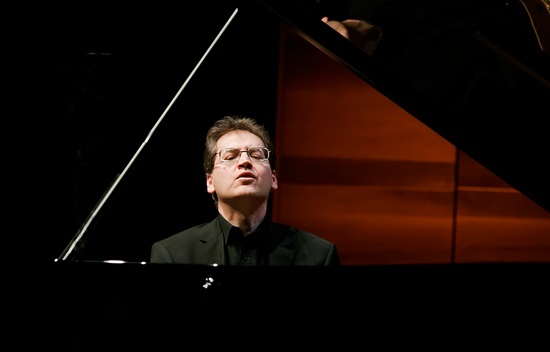Performances
Splendid singing and playing mark the DSO’s semi-staged”Die Walküre”
The Dallas Symphony Orchestra’s performance of Wagner’s Die Walküre, the second […]
Imaginative “Das Rheingold” sets the DSO’s semi-staged Ring cycle in motion
The Dallas Symphony Orchestra’s performance of Das Rheingold on Wednesday served not only […]
DSO festival presents contemporary works with a Parisian connection
Caruth Auditorium on the SMU campus hosted the first concert of […]
HGO’s compartmentalized staging makes for a mixed “Don Giovanni”
Mozart’s Don Giovanni famously ends with its sex-addict antihero being dragged […]
Young leads Dallas Symphony in music of questioning, contemplation
The Dallas Symphony Orchestra concert on Thursday night under the baton […]
Articles
Critic’s Choice 2023-24
Blanchard: Suite from Fire Shut Up in My Bones. Terence Blanchard […]
Houston Grand Opera eager to set sail with Smyth’s “The Wreckers”
Stage director Louisa Muller makes no pretense about her history with […]
Concert review
Dohnányi and Brahms quintets bring CMSFW season to impassioned close

The Chamber Music Society of Fort Worth’s concert series at the Modern Art Museum of Fort Worth concluded its season Saturday with a pair of romantic-era piano quintets. Violinists Will Hagen and CMSFW artistic director Gary Levinson were joined by violist Juan Miguel Hernandez, cellist Julian Schwarz, and Hungarian pianist Dénes Várjon.
Ernő Dohnányi’s Piano Quintet No. 1, written when the composer was eighteen, emphasized the piano part over those of the strings. Among European piano virtuosi, Dohnányi was unusual in his devotion to performing chamber music. Johannes Brahms, whom Dohnányi admired above all others early in his career, praised the quintet upon its completion and arranged for its premiere in Vienna.
Ensemble playing was most sensitive in the first movement. The two violinists were well matched in tone and volume, while all the strings produced a full sound. Várjon, with his fluid tone production, was able to hold his own. Tasteful pizzicati rose clearly through the textures, and the group’s dramatic unison passage near the end lifted the closing statement.
Beginning with the second movement, the performance became more heavy-handed. Despite sensitive exchanges in dialog among the instruments—particularly between strings and piano—weightiness in the strings frequently overwhelmed the keyboard. Scampering themes seemed rushed. Hernandez’s opening lyrical solo in the slow movement returned a singing quality to the piece, followed by smooth waves in slurred strings over a rippling piano part. Here the piano was brilliantly articulate, with Várjon making excellent choices regarding balance within the ensemble. The piece was most cohesive when the piano was directing the action. Hints of the viola solo returned to close the movement.
The finale first featured a startling mix of 5/4 and 6/4 meters for its opening theme. Following a clean, captivating five-part fugato section near the middle, stately themes in the piano and first violin stood out. Despite several buoyant moments, the work enjoyed less dynamic contrast than the composer notated, being played rather heavily at times. Exaggerated vibrato in the first violin and cello also rendered many of their lines wispy.
After intermission, the performers demonstrated an assuredness of style and musicality that suggested greater familiarity with the second work, Brahms’s Piano Quintet in F Minor. All five players seemed more comfortable with this piece, and a mature Brahms (he was in his thirties when he composed the quintet) provided more to work with: greater variety among themes, textures, and musical ideas.
The piano is more transparent in Brahms’s writing, with a more versatile role interwoven among all the parts. Ensemble playing was crisp, featuring nimble passages in the strings in the first movement. Schwarz and Hernandez produced full sonorities, while Levinson’s tone was opulent in several high passages during the development section. The performers achieved a greater dynamic range than in the Dohnányi, ably coordinating articulation and intonation in variously scored three-part unison themes.
Várjon led the way into the second movement, which the group played with fine pacing and cogent tempos. Hernandez’s solos again afforded opportunities to hear his luxuriant tone. Várjon brilliantly executed the several virtuosic piano passages throughout the work, but especially in the Scherzo, while contributing to the successful coordination of the motivic interplay between piano and strings. In the final movement, the liquid inflection of the strings again emphasized Levinson’s sweet tone. In addition to his steadfastness on bass parts, Schwarz’s impassioned sound lent soulfulness to his solos in the central section of the last movement.
While both quintets received a solid reading, listeners who stayed for the second half got a more accurate picture of what splendid chamber music playing can sound like.
Calendar
May 6
Dallas Chamber Music Society
Brooklyn Rider
Haydn: String Quartet […]
News
Texas Classical Review wants you!
Texas Classical Review has an immediate need for concert reviewers in […]
Larry Rachleff, 1955-2022
Larry Rachleff, a fiery conductor who was the founding music director […]

